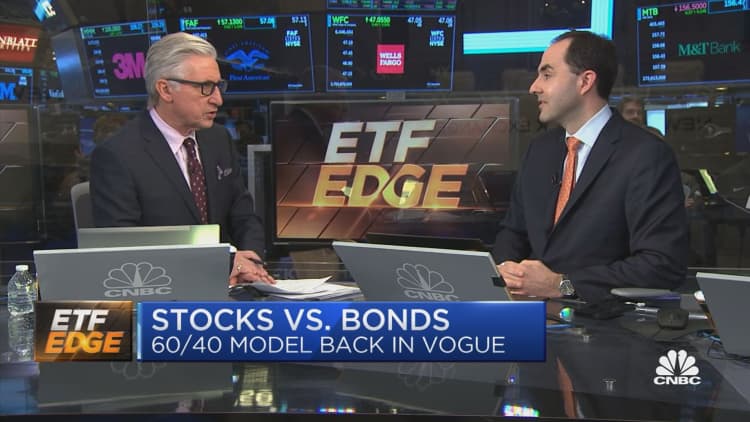
After a dismal year for the 60/40 stock/bond portfolio, the standard investing benchmark is making a comeback in 2023. And as yields on 2-year Treasurys approach 5%, single Treasury bond ETFs are attracting big inflows as investors seek balance in an uncertain inflationary environment.
"I think [bonds] absolutely are becoming a significant competitor to stocks," Dave Nadig, financial futurist at VettaFi, told Bob Pisani on CNBC's "ETF Edge" on Monday. "Frankly, to any risk asset."
Nadig pointed to the high-yielding parts of the inversion curve as an indication of continued rack rate increases from the Fed.
"That puts us in this position of having to really evaluate the risks of bonds coming down because of increased rates," he said. "Or looking at what's going on in the stock market where we're seeing some potential for margin compression."
The 2 Year Treasury yield closed the month of February on a tear, advancing more than 70 basis points for the month and climbing to 4.881% on Wednesday. The 1-year yield rose 3 basis points to over 5%. Yields move inversely to prices.
The 6 Month Treasury currently holds the highest Treasury yield at 5.148% as of Wednesday.
"On the short end of the curve, you get paid very quickly," Nadig said. "If you put money in a 6-month Treasury, you're going to collect 2.5% of that in just six months. That's incredible."
As investors weigh stock/bond allocations, Alex Morris, president and chief investment officer at F/m Investments, said in the same segment that that a healthier dose of Treasurys makes sense in this high-yield environment.
"If you're looking to get long term, say 8% out of that 60-equity percentage, you can get that today out of a bond portfolio with no risk," he said. "Seems like it's a good trade to make."
Among the funds seeing larger inflows this year are short maturity Treasury ETFs. The iShares Short Treasury Bond ETF (SHV) is comprised of securities with one to 12 months of remaining maturity.
The SPDR Portfolio Short Term Treasury ETF tracks between one and three years. Similarly, VettaFi's Vanguard Short-Term Treasury ETF (VGSH) focuses on exposure to bonds with that maturity duration.
"We know interest rates are going to keep going up," Nadig said. "You don't want to be in iShares 20+ Year Treasury Bond ETF (TLT) or the 20-year long bond if you know that you've got a 1% interest rate hike coming, because that's going to come right against your duration."
Nadig pointed out that it's practical for investors to allocate toward the short end of the curve but acknowledged that the availability of rates could sunset as this type of strategy gains steam.
"This is a rare opportunity," Nadig said. "I don't think we're going to be looking at an inverted yield curve, where you get paid more to own the short end than the long-dated end, for a significant amount of time. I think that lasts for maybe six-12 months tops when we get to a terminal rate."





